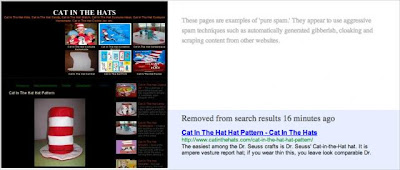This is an excellent way for a newbie to study the basics on how exactly Google crawls, indexes, positions and shows their search results. But how is this effective for a Search engine optimization spam like yourself? I'll layout the elements I find beneficial to more knowledgeable SEOs and webmasters.
Look Instances Of Spam Pages Erased From Google:
My favorite part is that Google is showing me some real examples of spam pages dragged from their index within the past several hours. You can observe those instances on this page and Google told us that these are latest examples of pages that "appear to utilize aggressive spam methods such as automatically generated gibberish, cloaking and scraping content from other websites." Before clicking and looking at them, you should be warned (by Google) "these screenshots are created automatically and are not manually filtered. While uncommon, you may see offensive, sexually explicit, or violent content."
Actually, I should have a page shortly that archives all of these examples for you to look back at historically. I'll share that page when it is done.
The following is my favorite sample spam page I've viewed most recently:
Charts Of Manual Actions By Category, Reconsideration Requests & Notifications
So what did Google inform us with these charts?
Manual Actions By Category: This graph demonstrates the quantity of domains that were affected by a manual action over time and is broken down by the different spam types. Google says only 0.22% of domains had been manually marked for removal.
The types of spam recorded here include pure spam, legacy, hacked site, unnatural links from your site, automatically created content, and infinite spaces, cloaking and/or sneaky redirects, thin content with little or no, added value, unnatural links to your site, parked domains, user-generated spam, hidden text and/or keyword, stuffing, spammy free hosts and dynamic, and DNS providers. You may learn more about these over here.
Reconsideration Requests: This chart displays the weekly quantity of reconsideration requests since 2006.
Webmaster Notifications: This graph shows the variety of spam notifications sent to website owners through Webmaster Tools since 2010.
At this point plot these charts against punishment you may have got to make yourself feel better and maybe to figure out how to fix an issue?
Published Google Quality Rater Guidelines:
Eventually, Google themselves thought I would publish the PDF document of the quality ratters guidelines. This write-up has been leaked lots of times; I guess it just made sense for Google to post it. What changed? Matt McGee covered that over here.
So those are the three things I would pull out as being most fascinating for SEOs and webmasters to look at.





